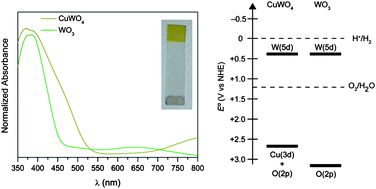Electrochemical deposition and photoelectrochemistry of CuWO4, a promising photoanode for wateroxidation†
Abstract
Polycrystalline thin film photoanodes composed of

* Corresponding authors
a
University of Michigan Department of Chemistry, 930 N. University Avenue, Ann Arbor, MI, USA
E-mail:
bartmb@umich.edu
Fax: +1(734) 647-4865
Tel: +1(734) 615-9279
Polycrystalline thin film photoanodes composed of

 Please wait while we load your content...
Something went wrong. Try again?
Please wait while we load your content...
Something went wrong. Try again?
J. E. Yourey and B. M. Bartlett, J. Mater. Chem., 2011, 21, 7651 DOI: 10.1039/C1JM11259G
To request permission to reproduce material from this article, please go to the Copyright Clearance Center request page.
If you are an author contributing to an RSC publication, you do not need to request permission provided correct acknowledgement is given.
If you are the author of this article, you do not need to request permission to reproduce figures and diagrams provided correct acknowledgement is given. If you want to reproduce the whole article in a third-party publication (excluding your thesis/dissertation for which permission is not required) please go to the Copyright Clearance Center request page.
Read more about how to correctly acknowledge RSC content.
 Fetching data from CrossRef.
Fetching data from CrossRef.
This may take some time to load.
Loading related content
